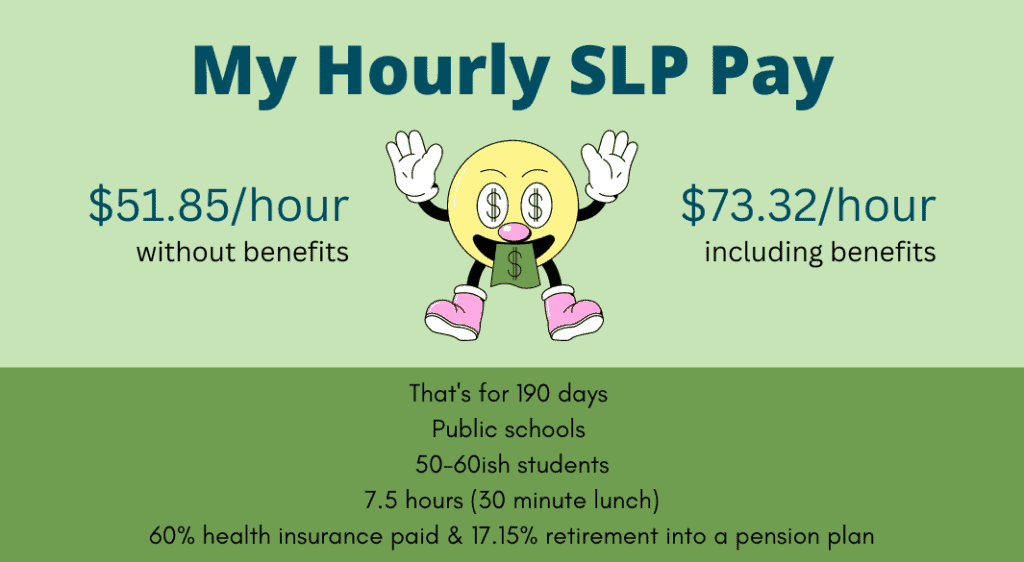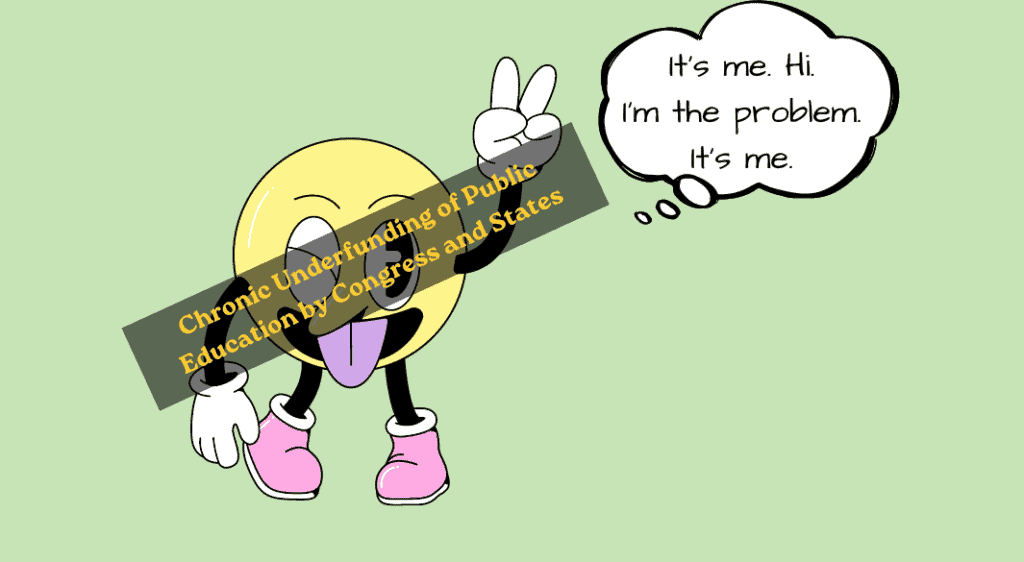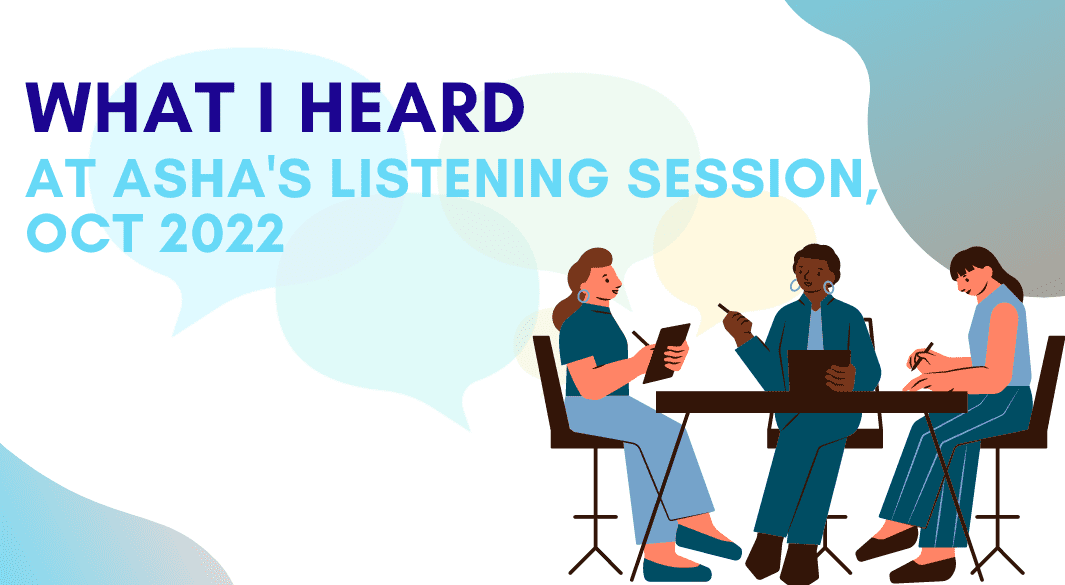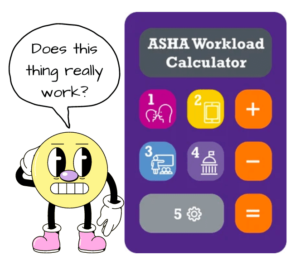I participated in the 2022 ASHA School Issues Advisory Board (SIAB) listening sessions recently. And these are the four big things that I heard.
Overall, it was a productive evening. The board had preorganized seed questions to encourage discussion. They gracefully framed the session and outlined its purposes in an attempt to ensure it didn’t devolve into something cathartic yet fruitless.
I recognized four main ideas from the call I was on:
- Workload
- Compensation
- Respect and dignity
- Assigning responsibility
Workloads are too high
Without a doubt, workload was the star of the session.
One of the members of the SIAB shared that ASHA used to have a simple “caseload cap” recommendation. It was scrapped for two main reasons:
1) No employer was paying attention to it, and
2) Many people thought that it was too blunt a measurement that didn’t take in account the many complexities and nuances in a caseload.
It was replaced with ASHA’s “Workload Calculator,” with the reminder that it is a guideline and that it bears nor regulatory not statutory weight.
There were some anecdotes about workload / caseload caps being helpful or useful tools for advocating for better working conditions. When advocating for better working conditions, it seemed to me people have found the most success through three things:
- Using quantitative data when talking with administration
- Collaborating with state advocacy leaders
- Collective action with colleagues
But overwhelmingly everyone wants ASHA to take a stronger posture against rising workloads.
Here’s my take:
I find workload calculators to be too complex, and they have too much “wiggle room” that can be used to dramatically underestimate certain job functions to balance the calculation. Further, they don’t leave any reserve capacity.
Workload caps or guidelines tend to be treated as a suggestion for what is “reasonable” rather than what they are: the absolute maximum amount of work that an experienced, well-trained, clinician with access to adequate resources in ideal conditions can handle.
I think of it kind of like the speed-limit.
The sign on the highway says 75. But if it is raining with traffic, at night, you probably shouldn’t be driving that fast.
Workload caps and formulas are similar. Maybe one SLP could provide quality-services to a caseload of 60 clients with varying levels of need while also being in compliance with the law and ethical principles. But in a period of unprecedented staffing shortages in all school-based positions, extraordinary turn-over throughout the public education system, and generally challenging times for all the other reasons we know, that same workload is not sustainable nor ethical.
Compensation: Not getting paid what we’re worth
Compensation was definitely a close second to workload as the star of the night.
Spolier alert: compensation is stagnant.
Some SLPs were offended about being included on the teacher salary schedules in their districts. I get that. But I think we’ll find more success in solidarity with teachers (and other school professionals) than in competition with them.
There was a bit of conversation around falling reimbursement rates form insurance companies (including Medicare/Medicaid), and one mention of a need to unionize and or take collective action.
I don’t disagree about those issues being important.
However, I believe that one of the best ways to increase our compensation and working conditions (apart from collective bargaining) is to start talking openly about what we’re paid. I shared this with the SIAB group on the call, and I’ll share it again here in the spirit of transparency:
My SLP pay:
As a CCC-SLP, I earn a base salary of $73,889 for 190 days of work at 7.5 hours a day. This includes my 30-minute, duty-free lunch. When calculating my hourly rate, my employer will not include the lunch time (to make the hourly rate seem higher). I include it because I’m not allowed to skip lunch and leave early, which makes it seem like part of my work day (even if I’m “off duty”).
$73,889 / 190 days = $388.88 per day.
$388.88 / 7.5 hours = $51.85 per hour.
That does not include benefits; the big ones are retirement and health insurance. To make a long story short, my employer pays 60% of my health insurance costs and contributes an amount equal to 17.15% of my salary to a pension plan.
Putting a dollar amount on those and adding them to my salary, my total compensation is $104,484.64 per year.
$104,484.64 / 190 days = $549.92 per day.
$549.92 / 7.5 hours = $73.32 per hour

Also, I have the option to work an additional hour daily for a $6,000 stipend (which is only $31.58 an hour). The intention of my employer is that I use that hour for medicaid billing. I didn’t include it in the above calculations because it is optional, a lower rate, and doesn’t impact my retirement the same way.
In whatever setting you work in, I encourage you to run the numbers and find out your hourly rate with and without benefits. Comparing annual salaries is not easy (and is often a tactic used to confuse employees) because the hours and days worked vary significantly.
Know your hourly rates and talk about them.
Respect & Dignity…what are those?
Respect and dignity weren’t the words used by SIAB or attendees, but I think they pretty well sum up several points of discussion. SLPs talked about things like…

- Other professions encroaching on our scope of practice
- Having appropriate work space in schools (i.e., working in closets)
- Being compared to other educational professionals (i.e., “we’re not teachers”)
- Increase in upset, aggressive, and/or litigious families
- How the COVID-19 pandemic has accelerated worrisome trends
- SLPs leaving the profession for lower-pressure jobs
There’s blame to share
Who is to blame for all of the stuff that is going wrong in the public schools?
In the call (and in the work place) there tended to be a heavy focus on the immediate actors: school principals and district-level administrators. There were tips and success stories on how to work with these groups.
Side note: Did you know there are State Education Advocacy Leaders (SEALs) in most states and that they’re great resources?
The conversation did broaden to include school boards, state legislatures, and the U.S. Congress.
And I think that is super important.
Our local leaders absolutely bear responsibility for the state of public education. But the others don’t get to escape blame.
And more importantly, they cannot escape their responsibility to act now to improve things.

Congress should pass the IDEA Full Funding Act (Senate version & House version) so that we can live up to the civil rights promise that was the IDEA. And we should call our elected officials to tell them to do it!
Public Education across the United States needs an overhaul with the federal government providing stability in hard times and states thinking about serving students rather than local property taxes.
As for local school boards, I believe their members need to be better informed about special education – what it is and how it benefits all students. I also wish they would be more transparent with voters about the challenges public schools are facing.
So, what’s next?
I heard a lot of issues that need addressing during the session, and I know the SIAB members did too. But they can’t do it alone.
We need to do our part by being informed citizens and voters, by being active members of organizations that align with our values, and by holding each other accountable through open and honest conversations.
Did you attend a listening session; if yes, what did you hear or say? And if you didn’t, what do you wish you would have said? Let me know in the comments below.



1 thought on “Four Things I Heard at ASHA’s Listening Session, Oct 2022”